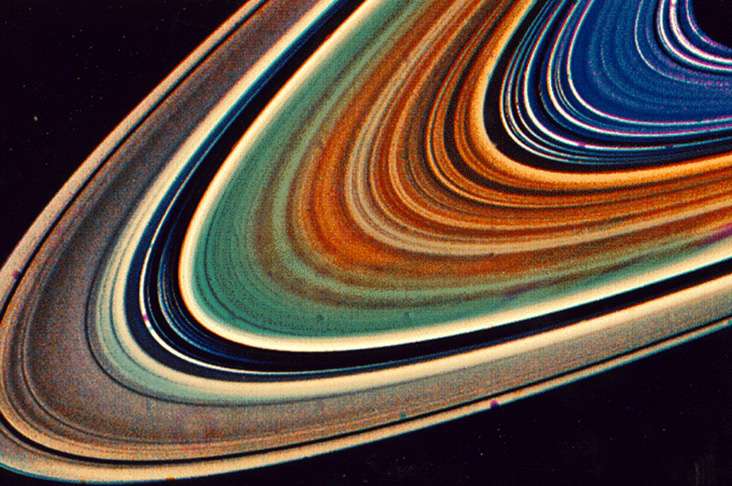Saturn's rings in a supercomputer

Why do some planets, like Saturn or Jupiter, have rings, while others, like Earth or Mars, do not? It turns out that "size does not matter"—gas giants like Saturn are not the only bodies that can possess rings; even tiny asteroids do. According to a recent discovery of the Spitzer Space Telescope, the remote asteroid Chariklo, which is only 260 km in diameter, also has rings.
Occasionally, in the far past, some planets had much more material in their vicinities then others, mostly in the form of dust. Dust particles merged together due to gravitational or adhesive forces, and larger and larger aggregates appeared in a system. This seems clear, but when did the particles cease to grow? What was the mechanism hindering their further growth?
Moreover, the particle size distribution followed, with a high accuracy, a beautiful mathematical law of "inverse cubes." This law implies that the abundance of particles of around two meters is eight times less than that of particles one meter in size; the abundance of particles of size three meters is respectively 27 times less, and so on. The reason for this distribution is another mystery.
An international team of scientists has resolved these questions of particle size distribution in Saturn's rings. They have shown that the observed size distribution is universal and is expected to be the same for all planetary rings, provided the rings' particles have a similar nature. Furthermore, the scientists unraveled the mystery of the "inverse cubes" law. The article, co-authored by professors Frank Spahn from the University of Potsdam, Germany, Jürgen Schmidt from the University of Oulu, Finland and Hisao Hayakawa from the Kyoto University, Japan, has been published in the journal Proceedings of the National Academy of Sciences.
Saturn's magnificent rings stretch by hundred of thousand kilometers outward from Saturn. In the other, perpendicular direction they are incredibly thin—only a few tens of meters, which makes the Saturn rings the most sharp object in nature, million times "sharper" than the sharpest razor. The rings consist of ice particle with a tiny addition of rocky material and orbit the planet with an enormous speed of 72,000 kilometers per hour. But this is an average or orbital speed, while the individual velocities have slightly different values. Commonly deviations from the orbital speed are extremely small, only a few meters per hour! When rings' particles collide with such low velocities, they merge, since the attractive surface forces keep them together. As a result a joint aggregate is formed, similar to what happens if two snowballs are squeezed together. In this way the rings' particles permanently merge. There exist, however, an opposite process: A very small fraction of particles has a significant deviation of their velocity from the average one. When such "fast" particles collide with the neighbors, both particles crumble into small pieces. This occurs very seldom but nevertheless leads to a steady balance between aggregation and fragmentation.
Scientists have constructed a mathematical model of the above processes in rings and studied this model by various methods. In particular, they solved a vast system of differential equations. This could be accomplished only with a use of a powerful supercomputer. This part of the work has been carried out by the Moscow team, who used Chebyshev—the supercomputer of the M.V. Lomonosov Moscow State University. Chebyshev, named in honor of a famous Russian mathematician, is one of the most powerful computers in Europe.
The researchers have solved the riddle of the inverse cubes law; they also explained why the abundance of particles above a certain size dramatically drops. Moreover, they revealed an important conclusion that followed from their model: The particle size distribution in planetary rings is universal. That is, it would follow the same laws provided the nature of the rings' particles is the same as that of the Saturn rings. According to the researchers, this universality is a well-grounded hypothesis. In order to confirm or to refute it, a thorough investigation of other rings is needed.
The results of the study entail a number of other scientific conclusions, including the mechanism of ring formation and evolution. The results show that the rings of Saturn are in a steady state. Furthermore, since the characteristic time of the rings' response to any external perturbation does not exceed 10,000 years, nothing catastrophic has happened to the rings since the Bronze Age.
According to the Nobel Prize winner in Physics and Fellow of the Royal Society Pyotr Kapitsa, "There's nothing more practical than a good theory." This statement, also attributed to a German-American psychologist Kurt Lewin, is totally relevant for the above research: The scientists have developed a universal mathematical tool that could be applied to a variety of systems in nature and industry. Whenever a system is comprised of particles that can merge by colliding at low velocities and break into small pieces by colliding at high velocities, the size distribution of particles will obey the same inverse cubes law.
Journal information: Proceedings of the National Academy of Sciences
Provided by Lomonosov Moscow State University





















